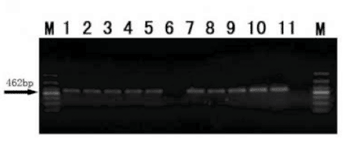Analysis of Saliva DNA Suggested for Screening Stroke-Linked Mutation
By LabMedica International staff writers
Posted on 06 Jan 2014
Results of real-time PCR analysis of saliva samples from stroke patients and normal controls obtained using a noninvasive magnetic nanoparticle-based technique were consistent with those from conventionally treated blood samples, which had been taken at the same time.Posted on 06 Jan 2014
C677T polymorphism in the methylenetetrahydrofolate reductase (MTHFR) gene is a risk factor for stroke, suggesting that widespread detection could help to prevent stroke. The MTHFR nucleotide at position 677 in the gene has two possibilities: C (cytosine) or T (thymine). C at position 677 (leading to an alanine at amino acid 222) is the normal allele. The 677T allele (leading to a valine substitution at amino acid 222) encodes a thermolabile enzyme with reduced activity. Individuals with two copies of 677C (677CC) have the "normal" or "wildtype" genotype. 677TT individuals (homozygous) have mild MTHFR deficiency. 677CT individuals (heterozygotes) are almost the same as normal individuals, since the one copy of normal MTHFR compensates for the other, thermolabile copy of MTHFR. Individuals with 677TT are predisposed to mild hyperhomocysteinemia (high blood homocysteine levels), as they have less active MTHFR available to produce 5-methyltetrahydrofolate.

Image: PCR products of methylenetetrahydrofolate reductase C677T DNA samples extracted with magnetic nanoparticles using saliva samples (lanes 1-5) and with traditional methods using blood samples (lanes 7-11) (Photo courtesy of Neural Regeneration Research).
Investigators at Peking University Shenzhen Hospital (Shenzhen, China) extracted DNA from saliva samples obtained from 70 stroke patients and 70 healthy controls using a magnetic nanoparticles-based method and from blood using conventional methods. Real-time PCR results revealed that the C677T polymorphism was genotyped by PCR using DNA extracted from both saliva and blood samples. The genotype results were confirmed by gene sequencing, and results for saliva and blood samples were consistent. The mutation TT genotype frequency was significantly higher in the stroke group than in controls. Homocysteine levels were significantly higher than controls in both TT genotype groups.
Based on these results, the authors proposed that, "This noninvasive magnetic nanoparticles-based method using saliva samples could be used to screen for the MTHFR C677T polymorphism in target populations."
The study was published in the November 15, 2013, issue of the journal Neural Regeneration Research.
Related Links:
Peking University Shenzhen Hospital














